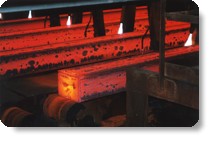
UHP arc furnace

The main equipment of steel production is the UHP arc furnace. This furnace was delivered and installed in 1982 by NIPPON-KOKAN (Japan) and upgraded in 1995 by MANNESMANN-DEMAG (Germany).
Nominal capacity of this furnace is 80 ton. It's equipped with carbon-oxygen blow system. During the steel production argon or nitrogen gas is being blown through the furnace through the porous brick which is built-in the bottom of the furnace.
Nominal capacity
of the furnace is 550 thousands of ton/year.
ASEA-SKF ladle metallurgical unit

ASEA-SKF ladle metallurgical unit is used in primary steel production equipment (for UHP arc furnace) for storage of melt and prepared steel and for its further fining. Technological processes executable at ASEA-SKF unit: drossing, scorification, homogenization, temperature increasing, alloying, desulfuration, non-ferrous impurities removal, degassing, vacuumization. Electromagnetic mixer and argon gas blowing into the ladle the porous brick which is built-in the bottom of the ladle increases the effectiveness of abovementioned processes.
Continuous casting
Billet half-finished product casting from alloyed and non-alloyed steels occurs on the 5 thread continuous caster. This caster was delivered and installed by KOBE-STEEL (Japan) company in 1982, and was upgraded in 1990, 1993 by VOEST-ALPINE Industrieanlagenbau GmbH. Austrian company. Now, after caster upgrade, it is possible to produce qualified microalloyed steels, billets or continuous casting production.
Possible sizes of billets: ![]() 120, 150,
180, 225 mm and 240 x 350 mm.
120, 150,
180, 225 mm and 240 x 350 mm.
Nominal capacity of the caster: 420 thousands ton/year.
Some of the steels from the production program of DAM 2004 Kft.:
Ingot casting
Base production:
Base is produced from solid burden in 80 ton UHP arc furnace, pre-alloyed during pouring into the ladle. After then base is being processed at ASEA unit: slag treatment, chemical composition and temperature set-up, deoxidizing, homogenization with magnetic mixing, degassing, impurities removal with vacuumization. Hydrogen content after vacuuming 1,5-2 ppm.
Source material is 72-78 ton of liquid steel.
Billet casting modes:
Bottom casting with steel-stream protection. In the case of 5000 mm height circle and polygon ingots bottom casting into teeming pit is applied, in the case of four and polygon billets bottom casting using teeming truck is applied. Teeming crane or stripping-crane, depending on billet type, is used for cast billets moving. Scale and speed-measuring device installed on the crane is used for casting speed adjustment and measuring.
Main parameters of the bell furnace which is used for controlled cooling of the cast billets:
Maximum load: ~ 70
ton
Maximum temperature: 850/900 °C
Temperature homogeneity: ± 5 °C
Heating gradient: max. 10/20 °C/70 ton
Zones number: 3
Burner number: 6
Cooling gradient: 10/20 °C/70 ton